A Systematic Bibliometric Review Analysis of Research on the Use of Waste Rubber Tyres in Building and Construction Materials and Their Applications
Abstract
1. Introduction
2. Methodology
2.1. Data Bases and Keywords
2.2. Data Compilation, Processing and Analysis
2.3. Correlation Analysis
3. Results and Discussion
3.1. Temporal Evolution of the Number of Publications andPublications by Type and Languages
3.2. Geographical Analysis
3.3. Research Activity of Institutions
3.4. Author Evolution and Documents
3.5. Global vs. Local Citations
3.6. Journal Analysis
3.7. Bibliometric Evolution in Research Areas
3.8. Keyword Analysis
4. Conclusions
Supplementary Materials
Author Contributions
Funding
Institutional Review Board Statement
Acknowledgments
Conflicts of Interest
References
- Cabeza, L.F.; Bai, Q.; Bertoldi, P.; Kihila, J.M.; Lucena, A.F.P.; Mata, É.; Mirasgedis, S.; Novikova, A.; Saheb, Y. Buildings. In IPCC, Climate Change 2022: Mitigation of Climate Change. Contribution of Working Group III to the Sixth Assessment Report of the Intergovernmental Panel on Climate Change; Cambridge University Press: Cambridge, UK; New York, NY, USA, 2022; pp. 953–1048. [Google Scholar] [CrossRef]
- Cabeza, L.F.; Bai, Q.; Bertoldi, P.; Kihila, J.M.; Lucena, A.F.P.; Mata, É.; Mirasgedis, S.; Novikova, A.; Saheb, Y. Buildings Supplementary Material. In Climate Change 2022: Mitigation of Climate Change. Contribution of Working Group III to the Sixth Assessment Report of the Intergovernmental Panel on Climate Change; Cambridge University Press: Cambridge, UK; New York, NY, USA, 2022; pp. 1–38. [Google Scholar]
- United Nations Environment Programme. United Nations Environment Programme, Y.C. for E. + A. In Building Materials and the Climate: Constructing a New Future; United Nations Environment Programme: Nairobi, Kenya, 2023. [Google Scholar]
- Qaidi, S.M.A.; Dinkha, Y.Z.; Haido, J.H.; Ali, M.H.; Tayeh, B.A. Engineering Properties of Sustainable Green Concrete Incorporating Eco-Friendly Aggregate of Crumb Rubber: A Review. J. Clean. Prod. 2021, 324, 129251. [Google Scholar] [CrossRef]
- Qaidi, S.M.A.; Mohammed, A.S.; Ahmed, H.U.; Faraj, R.H.; Emad, W.; Tayeh, B.A.; Althoey, F.; Zaid, O.; Sor, N.H. Rubberized Geopolymer Composites: A Comprehensive Review. Ceram. Int. 2022, 48, 24234–24259. [Google Scholar] [CrossRef]
- Mohanta, N.R.; Murmu, M. Alternative Coarse Aggregate for Sustainable and Eco-Friendly Concrete—A Review. J. Build. Eng. 2022, 59, 105079. [Google Scholar] [CrossRef]
- Thakare, A.A.; Singh, A.; Gupta, T.; Chaudhary, S. Effect of Size Variation of Fibre-Shaped Waste Tyre Rubber as Fine Aggregate on the Ductility of Self-Compacting Concrete. Environ. Sci. Pollut. Res. 2023, 30, 20031–20051. [Google Scholar] [CrossRef]
- UNEP’s. Our Use of Sand Brings Us “Up Against the Wall”, Says UNEP Report. 2022. Available online: https://www.unep.org/news-and-stories/press-release/our-use-sand-brings-us-against-wall-says-unep-report (accessed on 30 August 2024).
- World Bank Group. What a Waste: An Updated Look into the Future of Solid Waste Management; World Bank Group: Washington, DC, USA, 2018. [Google Scholar]
- Araujo-Morera, J.; Verdejo, R.; López-Manchado, M.A.; Hernández Santana, M. Sustainable Mobility: The Route of Tires through the Circular Economy Model. Waste Manag. 2021, 126, 309–322. [Google Scholar] [CrossRef]
- WBCSD. Global ELT Management-A Global State of Knowledge on Regulation, Management Systems, Impacts of Recovery and Technologies; World Business Council for Sustainable Development (WBCSD): Geneva, Switzerland, 2019; p. 57. [Google Scholar]
- Ferdous, W.; Manalo, A.; Siddique, R.; Mendis, P.; Zhuge, Y.; Wong, H.S.; Lokuge, W.; Aravinthan, T.; Schubel, P. Recycling of Landfill Wastes (Tyres, Plastics and Glass) in Construction—A Review on Global Waste Generation, Performance, Application and Future Opportunities. Resour. Conserv. Recycl. 2021, 173, 105745. [Google Scholar] [CrossRef]
- Hebel, D.; Wisniewska, M.H.; Heisel, F. Building from Waste: Recovered Materials in Architecture and Construction; Birkhäuser Verlag: Basel, Switzerland, 2014; ISBN 978-3-03821-520-3. [Google Scholar]
- Zrar, Y.J.; Younis, K.H.; Sherwani, A.F.H. Properties of Sustainable Self-Compacted Concrete with Recycled Concrete and Waste Tire Crumb Rubber Aggregates. Constr. Build. Mater. 2023, 407, 133524. [Google Scholar] [CrossRef]
- Mohammed, B.S.; Anwar, K.M.; Ting, J.; Swee, E.; Wong, G.; Abdullahi, M. Properties of Crumb Rubber Hollow Concrete Block. J. Clean. Prod. 2012, 23, 57–67. [Google Scholar] [CrossRef]
- Etli, S. Evaluation of the Effect of Silica Fume on the Fresh, Mechanical and Durability Properties of Self-Compacting Concrete Produced by Using Waste Rubber as Fine Aggregate. J. Clean. Prod. 2023, 384, 135590. [Google Scholar] [CrossRef]
- Gupta, T.; Chaudhary, S.; Sharma, R.K. Assessment of Mechanical and Durability Properties of Concrete Containing Waste Rubber Tire as Fine Aggregate. Constr. Build. Mater. 2014, 73, 562–574. [Google Scholar] [CrossRef]
- Lim, Z.H.; Lee, F.W.; Mo, K.H.; Chin, R.J.; Yeap, K.H.; Yew, M.K. An Investigation of the Mechanical Properties and Thermal Insulation of Foamed Rubberised Polypropylene Fibre Concrete That Incorporates a High Quantity of Crumb Rubber Granules. Polymers 2025, 17, 967. [Google Scholar] [CrossRef]
- Iqbal, H.W.; Hamcumpai, K.; Nuaklong, P.; Jongvivatsakul, P.; Likitlersuang, S.; Pothisiri, T.; Chintanapakdee, C.; Wijeyewickrema, A.C. Enhancing Fire Resistance in Geopolymer Concrete Containing Crumb Rubber with Graphene Nanoplatelets. Constr. Build. Mater. 2024, 426, 136115. [Google Scholar] [CrossRef]
- Keleş, Ö.F.; Bayrak, O.Ü.; Bayata, H.F. Experimental Investigation on Mechanical Properties of Sustainable Roller Compacted Concrete Pavement (RCCP) Containing Waste Rubbers as Alternative Aggregates. Constr. Build. Mater. 2024, 424, 135930. [Google Scholar] [CrossRef]
- Ahmed, S.; Elshazli, M.T.; Zaghlal, M.; Alashker, Y.; Abdo, A. Improving Shear Behavior of Rubberized Concrete Beams through Sustainable Integration of Waste Tire Steel Fibers and Treated Rubber. J. Build. Eng. 2024, 96, 110649. [Google Scholar] [CrossRef]
- Lavagna, L.; Nisticò, R.; Sarasso, M.; Pavese, M. An Analytical Mini-Review on the Compression Strength of Rubberized Concrete as a Function of the Amount of Recycled Tires Crumb Rubber. Materials 2020, 13, 1234. [Google Scholar] [CrossRef] [PubMed]
- Roychand, R.; Gravina, R.J.; Zhuge, Y.; Ma, X.; Youssf, O.; Mills, J.E. A Comprehensive Review on the Mechanical Properties of Waste Tire Rubber Concrete. Constr. Build. Mater. 2020, 237, 117651. [Google Scholar] [CrossRef]
- Assaggaf, R.A.; Ali, M.R.; Al-Dulaijan, S.U.; Maslehuddin, M. Properties of Concrete with Untreated and Treated Crumb Rubber—A Review. J. Mater. Res. Technol. 2021, 11, 1753–1798. [Google Scholar] [CrossRef]
- Arias-Cárdenas, B.; Lacasta, A.M.; Haurie, L. Bibliometric Analysis of Research on Thermal, Acoustic, and/or Fire Behaviour Characteristics in Bio-Based Building Materials. Constr. Build. Mater. 2024, 432, 136569. [Google Scholar] [CrossRef]
- Cañas-Guerrero, I.; Mazarrón, F.R.; Calleja-Perucho, C.; Pou-Merina, A. Bibliometric Analysis in the International Context of the “Construction & Building Technology” Category from the Web of Science Database. Constr. Build. Mater. 2014, 53, 13–25. [Google Scholar] [CrossRef]
- Chang, X.; Zhang, R.; Xiao, Y.; Chen, X.; Zhang, X.; Liu, G. Mapping of Publications on Asphalt Pavement and Bitumen Materials: A Bibliometric Review. Constr. Build. Mater. 2020, 234, 117370. [Google Scholar] [CrossRef]
- Kaur, P.; Kaur, G.J.; Routray, W.; Rahimi, J.; Nair, G.R.; Singh, A. Recent Advances in Utilization of Municipal Solid Waste for Production of Bioproducts: A Bibliometric Analysis. Case Stud. Chem. Environ. Eng. 2021, 4, 100164. [Google Scholar] [CrossRef]
- Akkenzheyeva, A.; Haritonovs, V.; Bussurmanova, A.; Merijs-meri, R. The Use of Rubber-Polymer Composites in Bitumen Modification for the Disposal of Rubber and Polymer Waste. Polymers 2024, 16, 3177. [Google Scholar] [CrossRef]
- Gañ, P.; Barajas, J.; Zuluaga, R.; Castro, C.; Mar, D.; Tercjak, A.; Builes, D.H. The Evolution and Future Trends of Unsaturated Polyester Biocomposites: A Bibliometric Analysis. Polymers 2023, 15, 2970. [Google Scholar] [CrossRef]
- Alkayal, N.S. Investigation into the Synthetic Strategies of Melamine-Based Porous Polymeric Materials: A Bibliometric Analysis. Polymers 2025, 17, 868. [Google Scholar] [CrossRef] [PubMed]
- Turner, J.; Daniel, E.I.; Chinyio, E. The Application for Innovative Methods and Materials for Greater Sustainability in Residential Buildings in the UK: “A Bibliometric Review”. Discov. Sustain. 2024, 5, 124. [Google Scholar] [CrossRef]
- Yang, D.; Zhao, J.; Ahmad, W.; Nasir Amin, M.; Aslam, F.; Khan, K.; Ahmad, A. Potential Use of Waste Eggshells in Cement-Based Materials: A Bibliographic Analysis and Review of the Material Properties. Constr. Build. Mater. 2022, 344, 128143. [Google Scholar] [CrossRef]
- Vazin, F.; Chan, D.W.M.; Hanaee, T.; Sarvari, H. Nature-Based Solutions and Climate Resilience: A Bibliographic Perspective through Science Mapping Analysis. Buildings 2024, 14, 1492. [Google Scholar] [CrossRef]
- Yataganbaba, A.; Kurtbaş, I. A Scientific Approach with Bibliometric Analysis Related to Brick and Tile Drying: A Review. Renew. Sustain. Energy Rev. 2016, 59, 206–224. [Google Scholar] [CrossRef]
- Salah Alaloul, W.; Al Salaheen, M.; Malkawi, A.B.; Alzubi, K.; Al-Sabaeei, A.M.; Ali Musarat, M. Utilizing of Oil Shale Ash as a Construction Material: A Systematic Review. Constr. Build. Mater. 2021, 299, 123844. [Google Scholar] [CrossRef]
- Page, M.J.; McKenzie, J.E.; Bossuyt, P.M.; Boutron, I.; Hoffmann, T.C.; Mulrow, C.D.; Shamseer, L.; Tetzlaff, J.M.; Akl, E.A.; Brennan, S.E.; et al. The PRISMA 2020 Statement: An Updated Guideline for Reporting Systematic Reviews. BMJ 2021, 372, 71. [Google Scholar] [CrossRef]
- Aria, M.; Cuccurullo, C. Bibliometrix: An R-Tool for Comprehensive Science Mapping Analysis. J. Informetr. 2017, 11, 959–975. [Google Scholar] [CrossRef]
- Wei, W.; Jiang, Z. A Bibliometrix-Based Visualization Analysis of International Studies on Conversations of People with Aphasia: Present and Prospects. Heliyon 2023, 9, e16839. [Google Scholar] [CrossRef] [PubMed]
- Rodríguez-Soler, R.; Uribe-Toril, J.; De Pablo Valenciano, J. Worldwide Trends in the Scientific Production on Rural Depopulation, a Bibliometric Analysis Using Bibliometrix R-Tool. Land Use Policy 2020, 97, 104787. [Google Scholar] [CrossRef]
- Hirsch, J.E. An Index to Quantify an Individual’s Scientific Research Output. Proc. Natl. Acad. Sci. USA 2005, 102, 16569–16572. [Google Scholar] [CrossRef]
- Castillo-DR Rosnery; Alva, A.; Paris-Viviana, O.; Bosch González, M. Replication Data for: A Bibliometric Analysis of Research on the Use of Waste Rubber Tyres in Building and Construction Materials and Their Applications. V2 ed. CORA. Repositori de Dades de Recerca. 2024. Available online: https://futur.upc.edu/40242359 (accessed on 15 December 2024).
- Found, N.A. Recycling—A Growth Industry. Met. Mater. 1973, 7, 460–462. [Google Scholar]
- Cox, W.L. Recycle and Reuse of Tires; American Society of Manufacturing Engineers: Southfield, MI, USA, 1974. [Google Scholar]
- Haag, P.R. Economic Recycling of Used Tyres|Wirtschaftliche Aufbereitung von Altreifen in Einem Schweizer Unternehmen. Gummi Asbest Kunststoffe 1975, 28, 780–782. [Google Scholar]
- Kara De Maeijer, P.; Craeye, B.; Blom, J.; Bervoets, L. Crumb Rubber in Concrete—The Barriers for Application in the Construction Industry. Infrastructures 2021, 6, 116. [Google Scholar] [CrossRef]
- Brundtland, G.H. Our common future—Call for action. Environ. Conserv. 1987, 14, 291–294. [Google Scholar] [CrossRef]
- ONU (Naciones Unidas). Conferencia de las Naciones Unidas sobre Medio Ambiente y Desarrollo, Río de Janeiro 1992. Available online: https://www.un.org/es/conferences/environment/rio1992 (accessed on 4 May 2023).
- ONU (Naciones Unidas). Conferencia de las Naciones Unidas sobre Medio Ambiente y Desarrollo, Río de Janeiro 2012. Available online: https://www.un.org/es/conferences/environment/rio2012 (accessed on 4 May 2023).
- European Commission. Closing the Loop: Commission Adopts Ambitious New Circular Economy Package to Boost Competitiveness, Create Jobs and Generate Sustainable Growth. NewEurope 2015, 13–15. [Google Scholar]
- European Commission. Council Decision of 19 December 2002 Establishing Criteria and Procedures for the Acceptance of Waste at Landfills Pursuant to Article 16 of and Annex II to Directive 1999/31/EC. European Council. Off. J. Eur. Communities 2003, 11, 27–49. [Google Scholar]
- European Union. Council Directive 1999/31/EC on the Landfill. Off. J. Eur. Communities 1999, L182, 1–19. [Google Scholar] [CrossRef]
- European Commission. Commission Regulation (EU) 2023/2055 of 25 September 2023 Amending Annex XVII to Regulation (EC) No 1907/2006 of the European Parliament and of the Council Concerning the Registration, Evaluation, Authorisation and Restriction of Chemicals (REACH) as Rega. Off. J. Eur. Union 2023, L 238, 67–88. [Google Scholar]
- Winternitz, K.; Heggie, M.; Baird, J. Extended Producer Responsibility for Waste Tyres in the EU: Lessons Learnt from Three Case Studies—Belgium, Italy and the Netherlands. Waste Manag. 2019, 89, 386–396. [Google Scholar] [CrossRef]
- UE. Directiva 2008/98/CE del Parlamento Europeo y del Consejo, de 19 de Noviembre de 2008, Sobre los Residuos y por la que se Derogan Determinadas Directivas; Parlamento Europeo; Unión Europea: Brussels, Belgium, 2008; 28p. [Google Scholar]
- European Comission. Regulation (EC) 1907/2006 of the European Parliament and of Teh Council of 18 December 2006—REACH. Off. J. Eur. Union 2006, 396, 396–849. [Google Scholar]
- European Commission. Regulation (EU) 2019/1020 of the European Parliament and of the Council of 20 June 2019; European Commission: Brussels, Belgium, 2019; pp. 48–119. [Google Scholar]
- Standing Committee of the 11th National People’s Congress of the People’s Republic of China. Circular Economy Promotion Law of the People’s Republic of China; promulgated 29 August 2008; effective 1 January 2009. Available online: https://english.mee.gov.cn/Resources/laws/envir_elatedlaws/201712/t20171212_427823.shtml (accessed on 20 September 2024).
- European Commission. China Waste Import Ban. Available online: https://trade.ec.europa.eu/access-to-markets/en/barriers/details?isSps=false&barrier_id=12962 (accessed on 25 September 2024).
- Wikipedia Contributors. China’s Waste Import Ban. In Wikipedia, The Free Encyclopedia. Available online: https://en.wikipedia.org/w/index.php?title=China%27s_waste_import_ban&oldid=1239102902 (accessed on 20 September 2024).
- Grasso, D. Resource Conservation and Recovery Act (RCRA). In Hazardous Waste Site Remediation; Routledge: London, UK, 2017; pp. 3–24. [Google Scholar]
- EPA. Wastes—Resource Conservation—Common Wastes & Materials—Scrap Tires. Available online: https://archive.epa.gov/epawaste/conserve/materials/tires/web/html/laws.html (accessed on 27 October 2021).
- National Environmental Council (CONAMA). Resolution No. 416: Health, Safety and Environment in B. 30 September 2009, Brazil. Available online: https://conama.mma.gov.br/images/conteudo/CONAMA-ingles.pdf (accessed on 5 September 2024).
- Wikipedia contributors. Gross Domestic Product. Available online: https://en.wikipedia.org/w/index.php?title=Gross_domestic_product&oldid=1253416205 (accessed on 1 October 2024).
- Wikipedia Contributors. List of Countries by Motor Vehicle Production. Available online: https://en.wikipedia.org/w/index.php?title=List_of_countries_by_motor_vehicle_production&oldid=1251760598 (accessed on 1 October 2024).
- Carlogos. The Largest Tire Manufacturers in the World (New). Available online: https://www.carlogos.org/reviews/largest-tire-manufacturers.html (accessed on 10 September 2024).
- ETRMA. Management Systems of End-of-Life Tyres. Available online: https://www.etrma.org/key-topics/circular-economy/ (accessed on 1 September 2024).
- Kambhampati, S.B.S.; Menon, J.; Maini, L. Ethics in Research and Publications. Indian J. Orthop. 2023, 57, 1722–1734. [Google Scholar] [CrossRef]
- Madhan, M.; Gunasekaran, S.; Arunachalam, S. Evaluation of Research in India—Are We Doing It Right? Indian J. Med. Ethics 2018, 3, 221–229. [Google Scholar] [CrossRef] [PubMed]
- Thomas, B.S.; Gupta, R.C.; Kalla, P.; Cseteneyi, L. Strength, Abrasion and Permeation Characteristics of Cement Concrete Containing Discarded Rubber Fine Aggregates. Constr. Build. Mater. 2014, 59, 204–212. [Google Scholar] [CrossRef]
- Thomas, B.S.; Gupta, R.C.; Mehra, P.; Kumar, S. Performance of High Strength Rubberized Concrete in Aggressive Environment. Constr. Build. Mater. 2015, 83, 320–326. [Google Scholar] [CrossRef]
- Rana, A.; Kalla, P.; Verma, H.K.; Mohnot, J.K. Recycling of Dimensional Stone Waste in Concrete: A Review. J. Clean. Prod. 2016, 135, 312–331. [Google Scholar] [CrossRef]
- Mohajerani, A.; Burnett, L.; Smith, J.V.; Markovski, S.; Rodwell, G.; Rahman, M.T.; Kurmus, H.; Mirzababaei, M.; Arulrajah, A.; Horpibulsuk, S.; et al. Recycling Waste Rubber Tyres in Construction Materials and Associated Environmental Considerations: A Review. Resour. Conserv. Recycl. 2020, 155, 104679. [Google Scholar] [CrossRef]
- Senin, M.S.; Shahidan, S.; Leman, A.S.; Hannan, N.I.R.R. Properties of Cement Mortar Containing Rubber Ash as Sand Replacement. IOP Conf. Ser. Mater. Sci. Eng. 2016, 160, 012055. [Google Scholar] [CrossRef]
- Li, D.; Toghroli, A.; Shariati, M.; Sajedi, F.; Bui, D.T.; Kianmehr, P.; Mohamad, E.T.; Khorami, M. Application of Polymer, Silica-Fume and Crushed Rubber in the Production of Pervious Concrete. Smart Struct. Syst. 2019, 23, 207–214. [Google Scholar] [CrossRef]
- Zhu, J.; Ma, T.; Dong, Z. Evaluation of Optimum Mixing Conditions for Rubberized Asphalt Mixture Containing Reclaimed Asphalt Pavement. Constr. Build. Mater. 2020, 234, 117426. [Google Scholar] [CrossRef]
- Tang, Y.; Feng, W.; Chen, Z.; Nong, Y.; Guan, S.; Sun, J. Fracture Behavior of a Sustainable Material: Recycled Concrete with Waste Crumb Rubber Subjected to Elevated Temperatures. J. Clean. Prod. 2021, 318, 128553. [Google Scholar] [CrossRef]
- Valente, M.; Sibai, A.; Sambucci, M. Extrusion-Based Additive Manufacturing of Concrete Products: Revolutionizing and Remodeling the Construction Industry. J. Compos. Sci. 2019, 3, 88. [Google Scholar] [CrossRef]
- Valente, M.; Sambucci, M.; Chougan, M.; Ghaffar, S.H. Reducing the Emission of Climate-Altering Substances in Cementitious Materials: A Comparison between Alkali-Activated Materials and Portland Cement-Based Composites Incorporating Recycled Tire Rubber. J. Clean. Prod. 2022, 333, 130013. [Google Scholar] [CrossRef]
- Angelin, A.F.; Andrade, M.F.F.; Bonatti, R.; Cecche Lintz, R.C.; Gachet-Barbosa, L.A.; Osório, W.R. Effects of Spheroid and Fiber-like Waste-Tire Rubbers on Interrelation of Strength-to-Porosity in Rubberized Cement and Mortars. Constr. Build. Mater. 2015, 95, 525–536. [Google Scholar] [CrossRef]
- Záleská, M.; Pavlík, Z.; Čítek, D.; Jankovský, O.; Pavlíková, M. Eco-Friendly Concrete with Scrap-Tyre-Rubber-Based Aggregate—Properties and Thermal Stability. Constr. Build. Mater. 2019, 225, 709–722. [Google Scholar] [CrossRef]
- Siddique, R.; Naik, T.R. Properties of Concrete Containing Scrap-Tire Rubber—An Overview. Waste Manag. 2004, 24, 563–569. [Google Scholar] [CrossRef]
- Khatib, Z.K.; Bayomy, F.M. Rubberized Portland Cement Concrete. J. Mater. Civ. Eng. 1999, 11, 206–213. [Google Scholar] [CrossRef]
- Khaloo, A.R.; Dehestani, M.; Rahmatabadi, P. Mechanical Properties of Concrete Containing a High Volume of Tire—Rubber Particles. Waste Manag. 2008, 28, 2472–2482. [Google Scholar] [CrossRef] [PubMed]
- Aiello, M.A.; Leuzzi, F. Waste Tyre Rubberized Concrete: Properties at Fresh and Hardened State. Waste Manag. 2010, 30, 1696–1704. [Google Scholar] [CrossRef]
- Onuaguluchi, O.; Panesar, D.K. Hardened Properties of Concrete Mixtures Containing Pre-Coated Crumb Rubber and Silica Fume. J. Clean. Prod. 2014, 82, 125–131. [Google Scholar] [CrossRef]
- Issa, C.A.; Salem, G. Utilization of Recycled Crumb Rubber as Fine Aggregates in Concrete Mix Design. Constr. Build. Mater. 2013, 42, 48–52. [Google Scholar] [CrossRef]
- Fattuhi, N.I.; Clark, L.A. Cement-Based Materials Containing Shredded Scrap Truck Tyre Rubber. Constr. Build. Mater. 1996, 10, 229–236. [Google Scholar] [CrossRef]
- Taha, M.M.R.; El-Dieb, A.S.; El-Wahab, M.A.A.; Abdel-Hameed, M.E. Mechanical, Fracture, and Microstructural Investigations of Rubber Concrete. J. Mater. Civ. Eng. 2008, 20, 640–649. [Google Scholar] [CrossRef]
- Batayneh, M.K.; Marie, I.; Asi, I. Promoting the Use of Crumb Rubber Concrete in Developing Countries. Waste Manag. 2008, 28, 2171–2176. [Google Scholar] [CrossRef]
- Mei, J.; Xu, G.; Ahmad, W.; Khan, K.; Amin, M.N.; Aslam, F.; Alaskar, A. Promoting Sustainable Materials Using Recycled Rubber in Concrete: A Review. J. Clean. Prod. 2022, 373, 133927. [Google Scholar] [CrossRef]
- Graça, C.A.L.; Rocha, F.; Gomes, F.O.; Rocha, M.R.; Homem, V.; Alves, A.; Ratola, N. Presence of Metals and Metalloids in Crumb Rubber Used as Infill of Worldwide Synthetic Turf Pitches: Exposure and Risk Assessment. Chemosphere 2022, 299, 134379. [Google Scholar] [CrossRef]
- Diekmann, A.; Giese, U.; Schaumann, I. Polycyclic Aromatic Hydrocarbons in Consumer Goods Made from Recycled Rubber Material: A Review. Chemosphere 2019, 220, 1163–1178. [Google Scholar] [CrossRef] [PubMed]
- Fathollahi, A.; Makoundou, C.; Coupe, S.J.; Sangiorgi, C. Leaching of PAHs from Rubber Modified Asphalt Pavements. Sci. Total Environ. 2022, 826, 153983. [Google Scholar] [CrossRef] [PubMed]
- Grynkiewicz-Bylina, B.; Słomka-Słupik, B.; Rakwic, B. Tests of Cement and Slag Mortars with SBR Rubber Granulates in Terms of Ecotoxicity and Strength. Inz. Miner. 2023, 2, 153–162. [Google Scholar] [CrossRef]
- Shu, X.; Huang, B. Recycling of Waste Tire Rubber in Asphalt and Portland Cement Concrete: An Overview. Constr. Build. Mater. 2014, 67 Pt B, 217–224. [Google Scholar] [CrossRef]
- Al-Tarbi, S.M.; Baghabra Al-Amoudi, O.S.; Al-Osta, M.A.; Al-Awsh, W.A.; Ali, M.R.; Maslehuddin, M. Development of Eco-Friendly Hollow Concrete Blocks in the Field Using Wasted High-Density Polyethylene, Low-Density Polyethylene, and Crumb Tire Rubber. J. Mater. Res. Technol. 2022, 21, 1915–1932. [Google Scholar] [CrossRef]
- Xu, J.; Yao, Z.; Yang, G.; Han, Q. Research on Crumb Rubber Concrete: From a Multi-Scale Review. Constr. Build. Mater. 2020, 232, 117282. [Google Scholar] [CrossRef]
- Di Mundo, R.; Petrella, A.; Notarnicola, M. Surface and Bulk Hydrophobic Cement Composites by Tyre Rubber Addition. Constr. Build. Mater. 2018, 172, 176–184. [Google Scholar] [CrossRef]
- Aliabdo, A.A.; Abd Elmoaty, A.E.M.; Abdelbaset, M.M. Utilization of Waste Rubber in Non-Structural Applications. Constr. Build. Mater. 2015, 91, 195–207. [Google Scholar] [CrossRef]
- Liu, B.; Yang, S.; Li, W.; Zhang, M. Damping Dissipation Properties of Rubberized Concrete and Its Application in Anti-Collision of Bridge Piers. Constr. Build. Mater. 2020, 236, 117286. [Google Scholar] [CrossRef]
- Valente, M.; Sambucci, M.; Chougan, M.; Ghaffar, S.H. Composite Alkali-Activated Materials with Waste Tire Rubber Designed for Additive Manufacturing: An Eco-Sustainable and Energy Saving Approach. J. Mater. Res. Technol. 2023, 24, 3098–3117. [Google Scholar] [CrossRef]
- Oliveira, E.A.d.; Guerreiro, M.J.d.S.; Abreu, I.; Dinis, M.A.P. Environmental Implications of CO2 Absorption by Pervious Concrete Pavement in Urban Roads. In Proceedings of the XIII CTV 2019 Proceedings: XIII International Conference on Virtual City and Territory: “Challenges and Paradigms of the Contemporary City”: UPC, Barcelona, Spain, 2–4 October 2019; pp. 1–14. [Google Scholar] [CrossRef]
- Mendes, R.F.; Santos Viana, Q.; Matheus, T.; Eugênio, C.; Mendes, J.F.; Resende, C.; Narciso, P.; Pereira Vilela, A. Study of the Use of Polymeric Waste as Reinforcement for Extruded Fiber-Cement. Environ. Sci. Pollut. Res. 2021, 28, 42737–42749. [Google Scholar] [CrossRef]
- Valente, M.; Sambucci, M.; Sibai, A.; Iannone, A. Novel Cement-Based Sandwich Composites Engineered with Ground Waste Tire Rubber: Design, Production, and Preliminary Results. Mater. Today Sustain. 2022, 20, 100247. [Google Scholar] [CrossRef]
- Marques, B.; António, J.; Almeida, J.; Tadeu, A.; de Brito, J.; Dias, S.; Pedro, F.; Sena, J.D. Vibro-Acoustic Behaviour of Polymer-Based Composite Materials Produced with Rice Husk and Recycled Rubber Granules. Constr. Build. Mater. 2020, 264, 120221. [Google Scholar] [CrossRef]
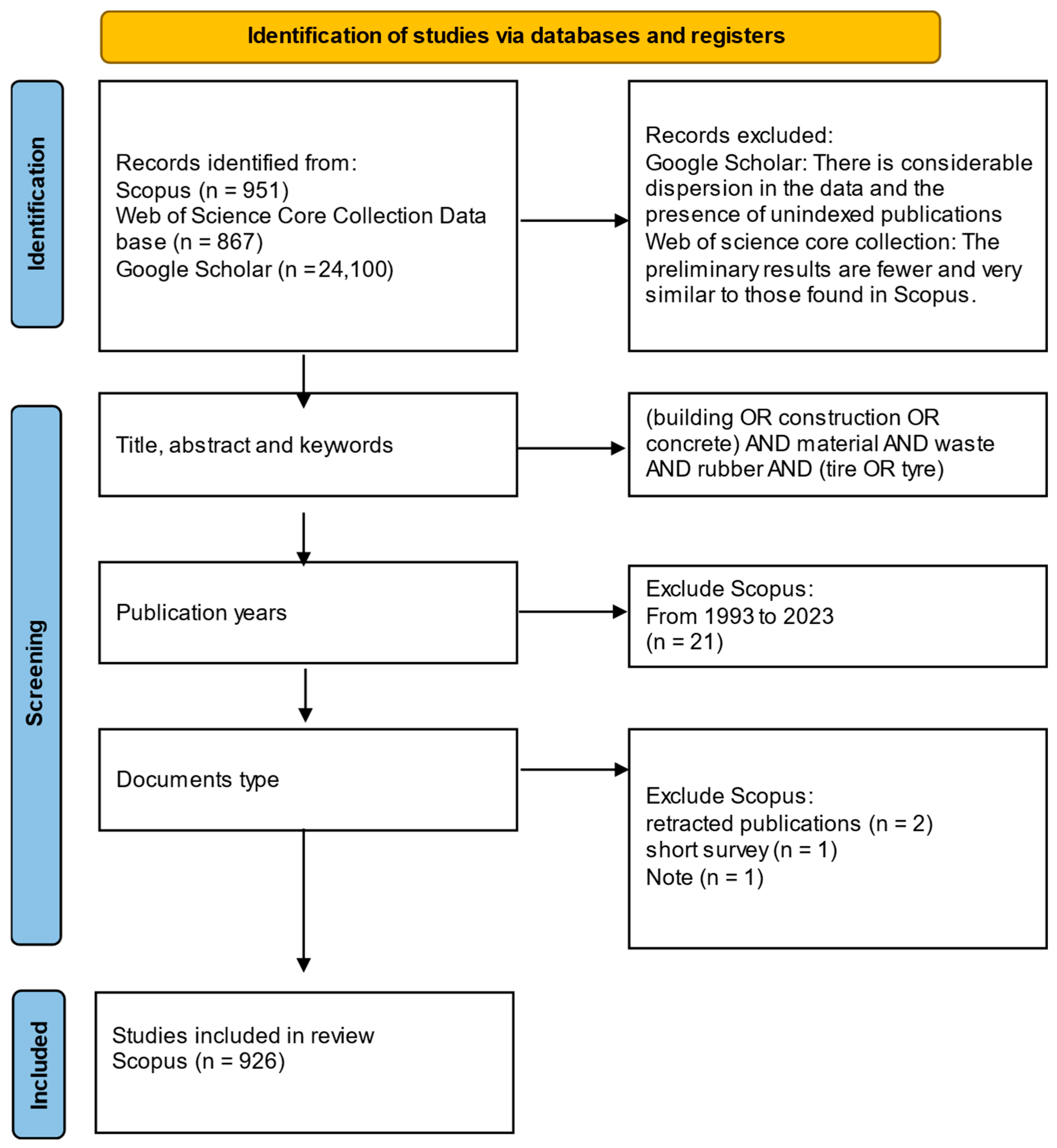
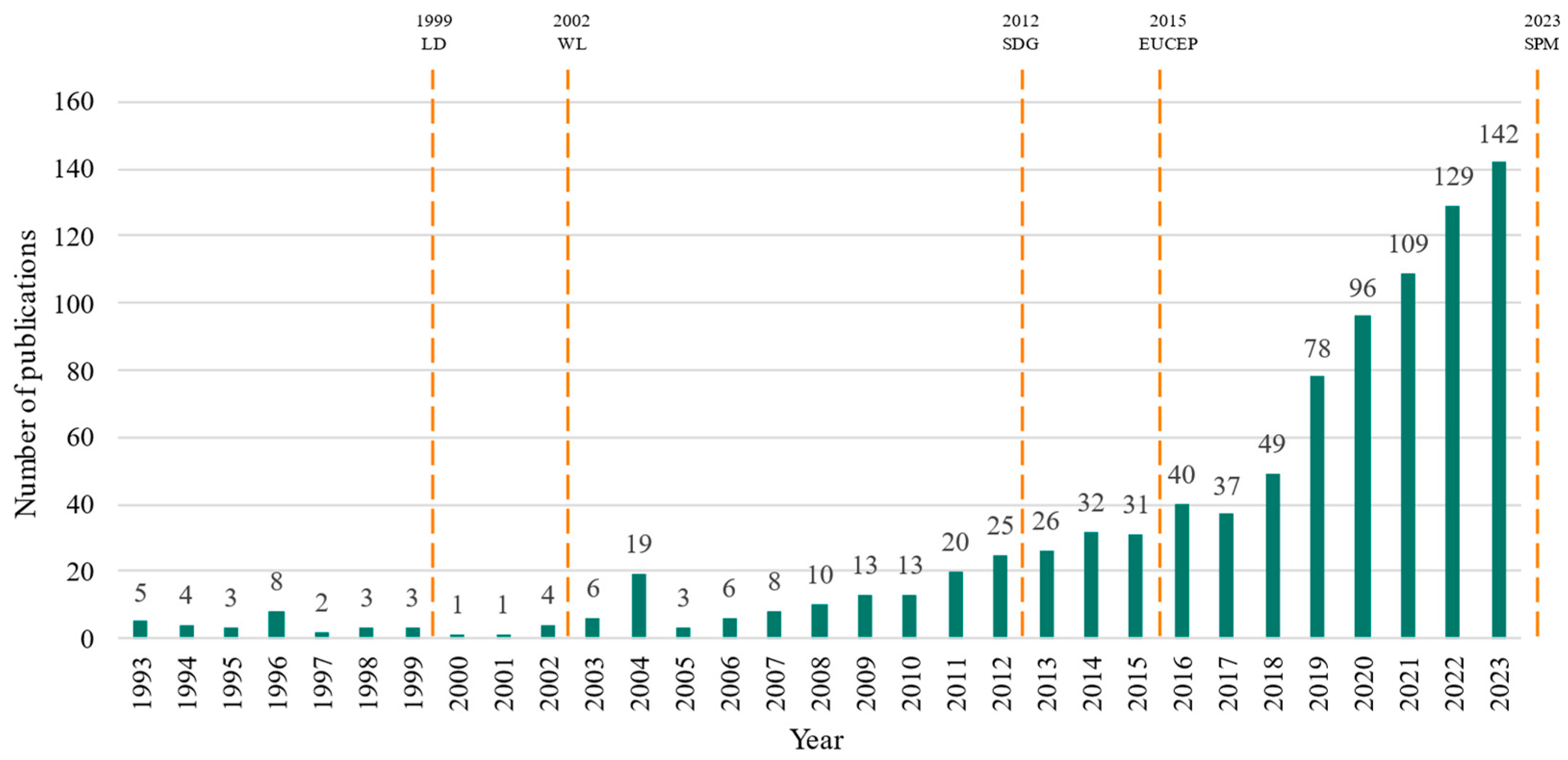
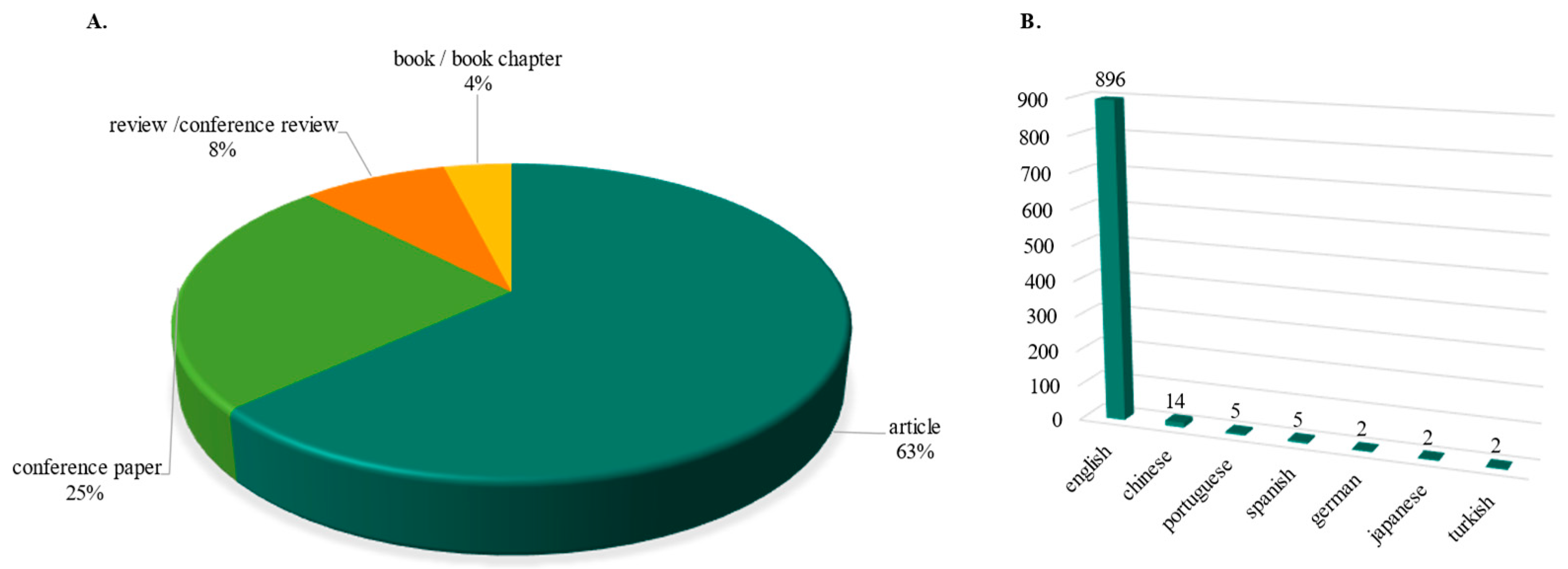

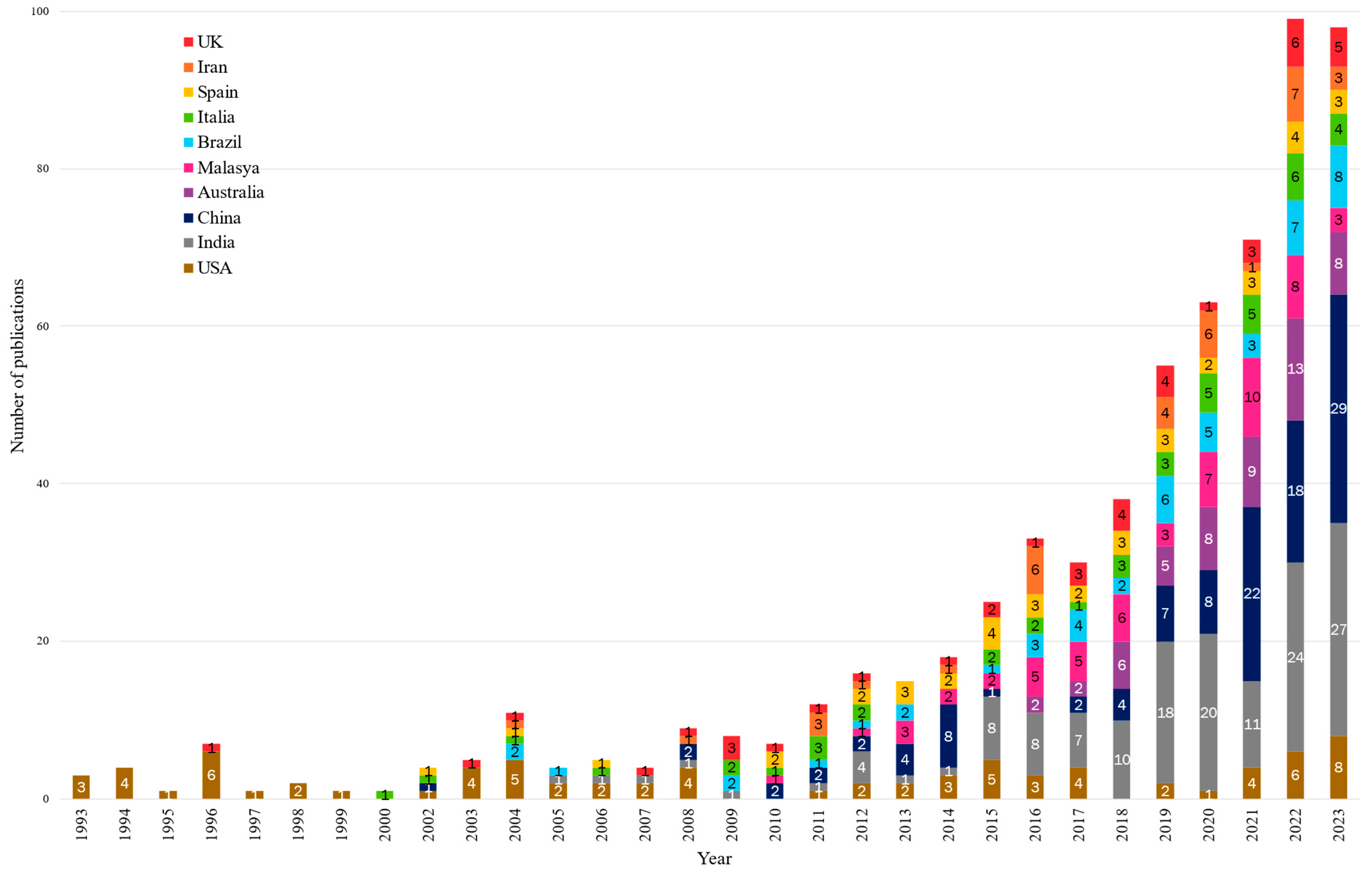
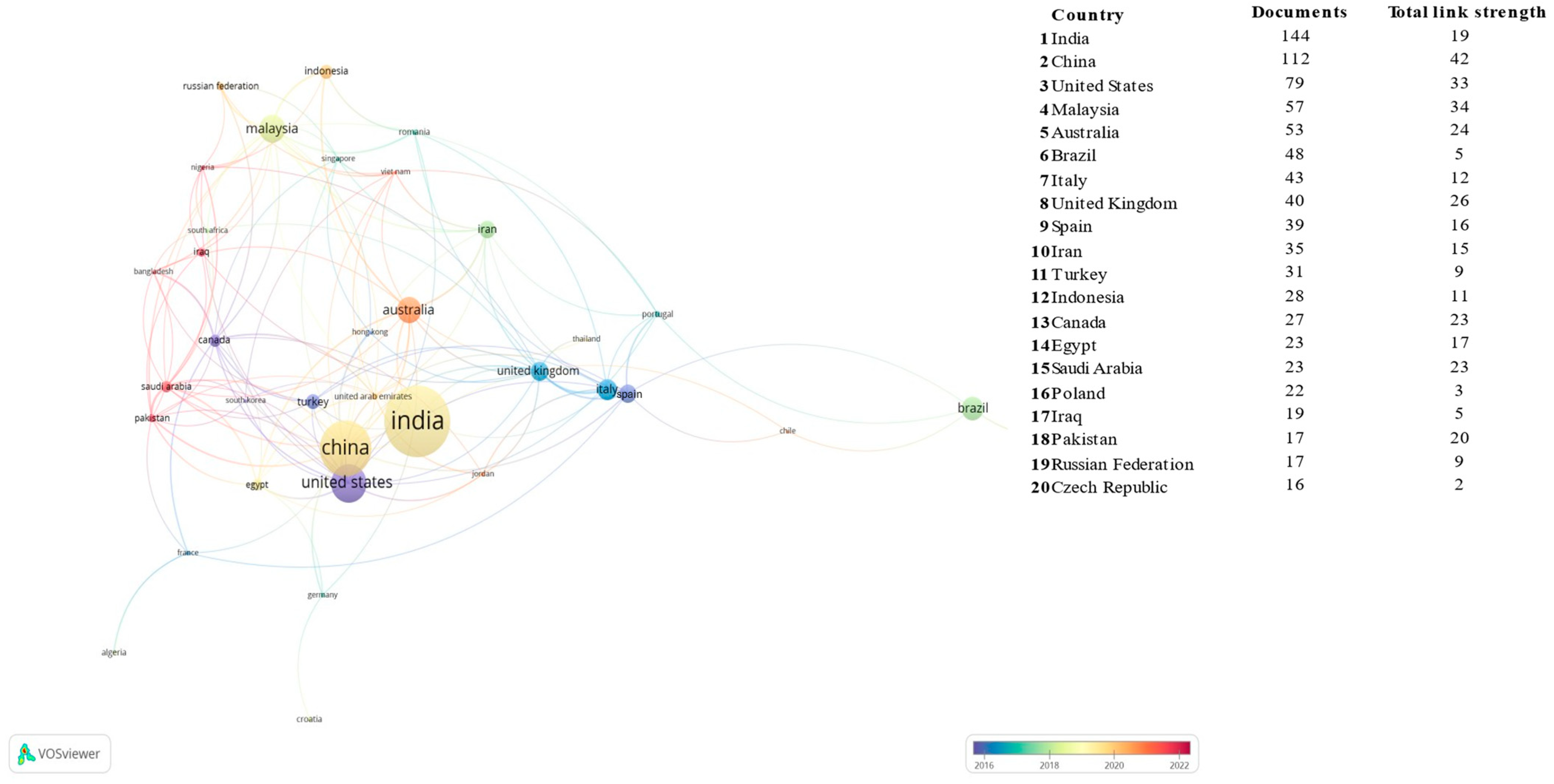


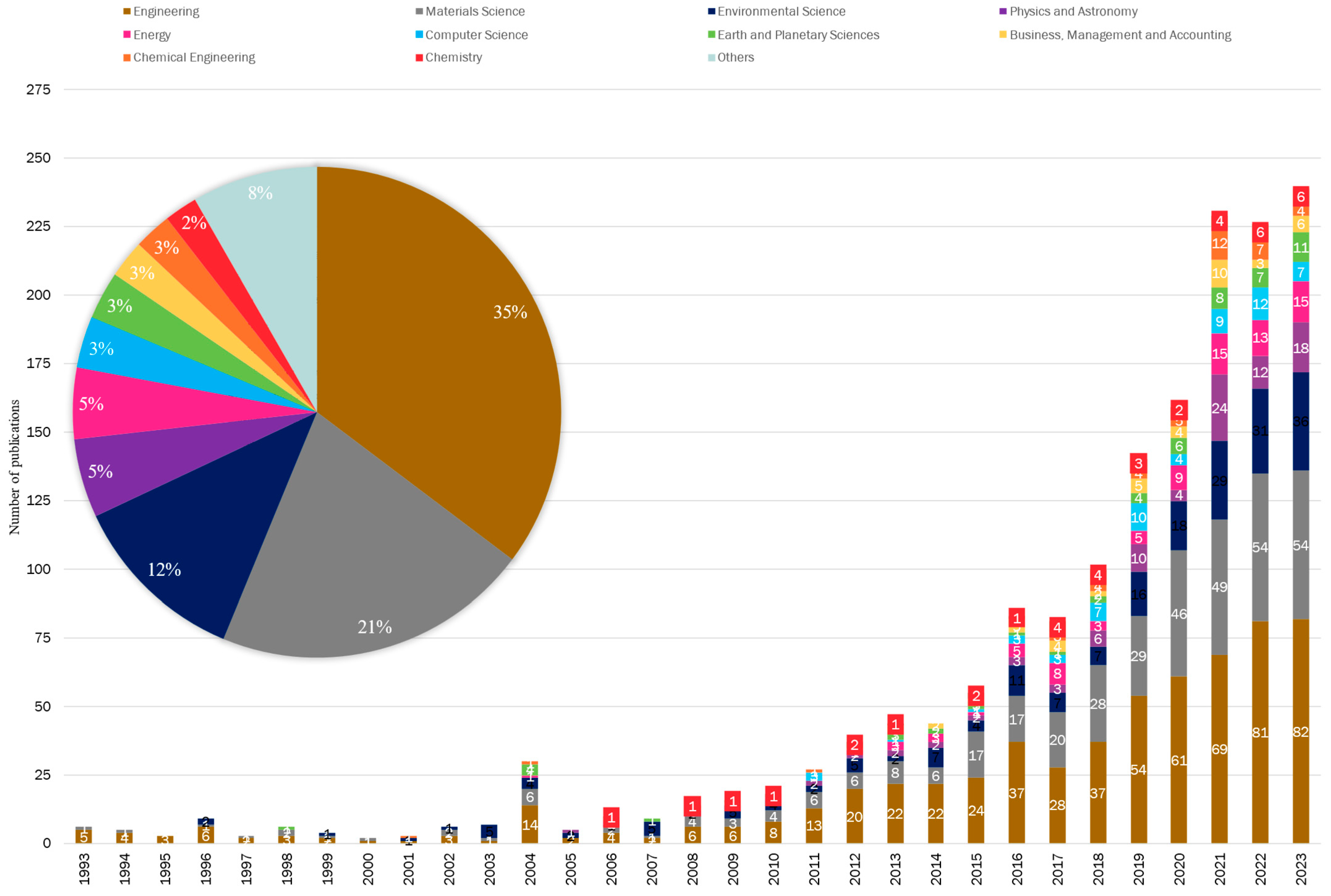
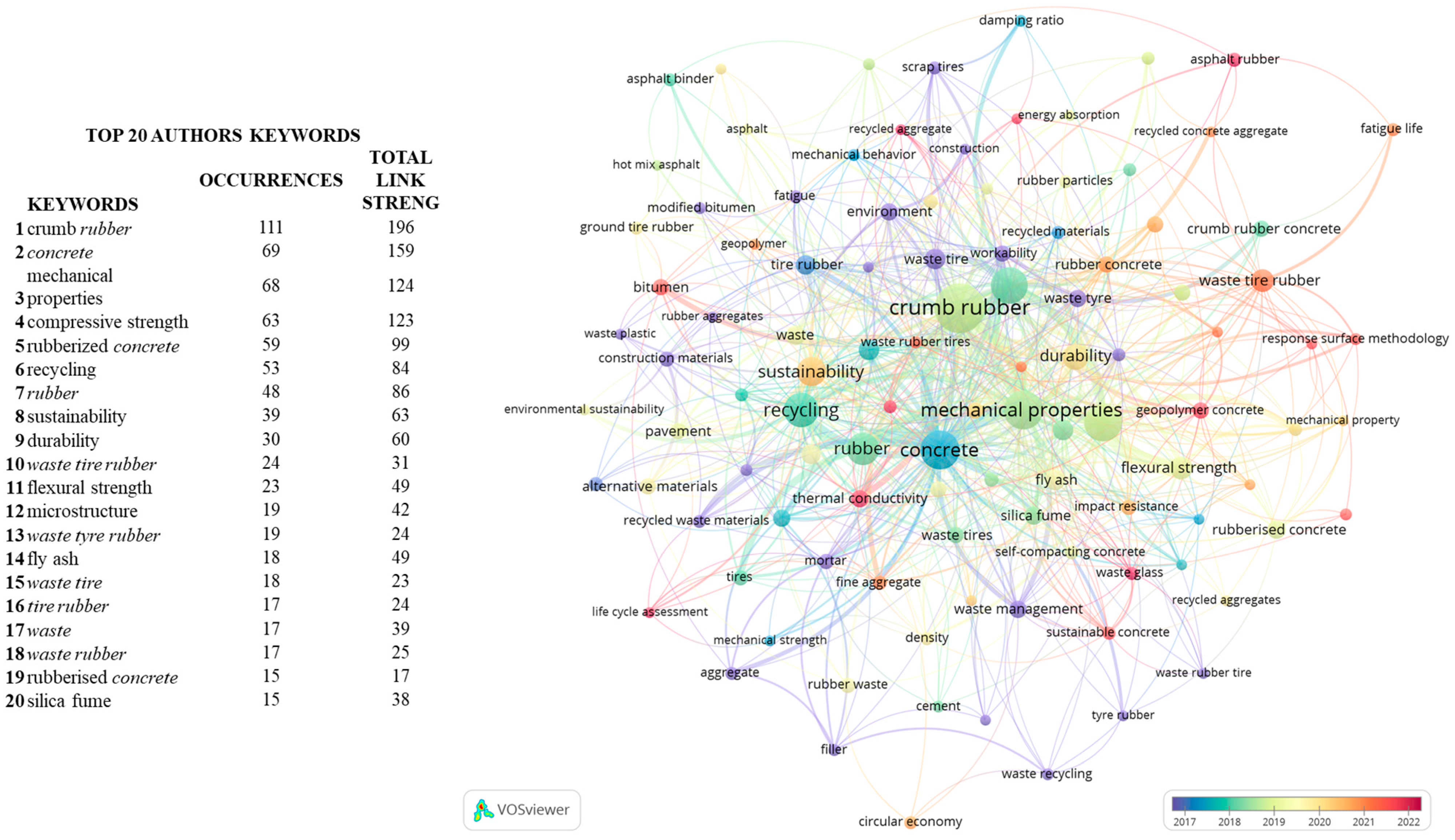

| Databases | Search Results | Query |
|---|---|---|
| SCOPUS | 926 | TITLE-ABS-KEY ((BUILDING OR CONSTRUCTION OR CONCRETE) AND MATERIAL AND WASTE AND RUBBER AND (TIRE OR TYRE)) AND PUBYEAR > 1992 AND PUBYEAR < 2024 AND (LIMIT-TO (PUBSTAGE, “FINAL”)) AND (EXCLUDE (DOCTYPE, “NO”) OR EXCLUDE (DOCTYPE, “SH”) OR EXCLUDE (DOCTYPE, “TB”)) |
| Web of Science Core Collection | 863 | REFINE RESULTS FOR (BUILDING OR CONSTRUCTION OR CONCRETE) AND MATERIAL AND WASTE AND RUBBER AND (TIRE OR TYRE) (TOPIC) AND 2024 (EXCLUDE–FINAL PUBLICATION YEAR) https://www.webofscience.com/wos/woscc/summary/e3dc33b2-a58b-4933-83cd-4b0b636e9aee-f87b8a15/relevance/1 (accessed on 3 July 2024) |
| Country | Total Publications | Total Cited | Average Citations per Document | Local H-Index | International Co-Authorship (%) |
|---|---|---|---|---|---|
| India | 144 | 2896 | 20.1 | 24 | 16 |
| China | 112 | 2664 | 23.8 | 28 | 40 |
| USA | 79 | 5395 | 68.3 | 29 | 45 |
| Malaysia | 57 | 1158 | 20.3 | 17 | 72 |
| Australia | 53 | 2844 | 53.7 | 20 | 47 |
| Brazil | 48 | 398 | 8.3 | 11 | 17 |
| Italy | 43 | 1615 | 37.6 | 19 | 37 |
| UK | 40 | 2290 | 57.3 | 18 | 68 |
| Spain | 39 | 1977 | 50.7 | 19 | 51 |
| Iran | 35 | 1788 | 51.1 | 17 | 57 |
| Pearson | Kendall | Total Publications | Number of Citations | Average Citations per Document | Local H-Index | International Co-Authorship (%) |
|---|---|---|---|---|---|
| Total publications | 1.00 | 1.00 | 0.42 | 0.33 | −0.37 | −0.24 | 0.67 | 0.43 | −0.52 | −0.38 |
| Number of citations | 0.42 | 0.33 | 1.00 | 1.00 | 0.63 | 0.42 | 0.86 | 0.75 | 0.01 | −0.16 |
| Average citations per document | −0.37 | −0.24 | 0.63 | 0.42 | 1.00 | 1.00 | 0.32 | 0.25 | 0.49 | 0.33 |
| Local H-index | 0.67 | 0.43 | 0.86 | 0.75 | 0.32 | 0.25 | 1.00 | 1.00 | −0.07 | −0.30 |
| International co-authorship | −0.52 | −0.38 | 0.01 | −0.16 | 0.49 | 0.33 | −0.07 | −0.30 | 1.00 | 1.00 |
| Affiliation | Total Publications | Number of Citations | H-Index Local | Average Citations per Document | Country |
|---|---|---|---|---|---|
| Malaviya National Institute of Technology Jaipur (MNIT) | 18 | 1410 | 10 | 78.3 | India |
| Royal Melbourne Institute of Technology (RMIT University) | 17 | 1068 | 8 | 62.8 | Australia |
| Universiti Tun Hussein Onn Malaysia (UTHM) | 15 | 165 | 8 | 11.0 | Malaysia |
| Southeast University (SEU) | 14 | 204 | 6 | 14.6 | China |
| Universiti Teknologi Malaysia (UTM) | 13 | 357 | 5 | 27.5 | Malaysia |
| Islamic Azad University | 12 | 421 | 7 | 35.1 | Iran |
| Sapienza University of Rome | 12 | 329 | 6 | 27.4 | Italy |
| Universidade Estadual de Campinas (UNICAMP) | 12 | 101 | 2 | 8.4 | Brazil |
| Czech Technical University in Prague (CTU) | 11 | 118 | 3 | 10.7 | Czech Republic |
| Ministry of Education of The People’s Republic of China | 11 | 324 | 4 | 29.5 | China |
| Author | Local | Global/Scopus Metric | Affiliations | |||||
|---|---|---|---|---|---|---|---|---|
| Number of Publications | Total Number of Citations | Average Citations per Document | Local H-Index | Global H-Index | Number of Publications | Total Number of Citations | ||
| Marco Valente | 12 | 329 | 27.4 | 11 | 21 | 68 | 1843 | Sapienza Università di Roma, Rome, Italy |
| Sandeep Chaudhary | 11 | 490 | 44.5 | 8 | 29 | 120 | 3489 | Indian Institute of Technology Indore, Indore, India |
| Rosa C. Cecche Lintz | 11 | 50 | 4.5 | 4 | 9 | 52 | 517 | Universidade Estadual de Campinas, Campinas, Brazil |
| Matteo Sambucci | 11 | 296 | 26.9 | 10 | 14 | 31 | 491 | Sapienza Università di Roma, Rome, Italy |
| Jie Li | 10 | 303 | 30.3 | 8 | 41 | 204 | 4432 | RMIT University, Melbourne, Australia |
| Zbyšek Pavlík | 9 | 118 | 13.1 | 4 | 35 | 363 | 3803 | Czech Technical University in Prague, Prague, Czech Republic |
| Milena Pavlíková | 9 | 118 | 13.1 | 4 | 28 | 267 | 2494 | Czech Technical University in Prague, Prague, Czech Republic |
| Mohammad Saberian | 8 | 219 | 27.4 | 6 | 37 | 95 | 2923 | RMIT University, Melbourne, Australia |
| Shahiron Shahidan | 8 | 95 | 11.9 | 6 | 25 | 210 | 2186 | Universiti Tun Hussein Onn Malaysia, Batu Pahat, Malaysia |
| Yan Zhuge | 7 | 403 | 57.6 | 5 | 40 | 253 | 5989 | University of South Australia, Adelaide, Australia |
| Year | Document | Author | DOI | Local Citations | Global Citations | Cited Ref |
|---|---|---|---|---|---|---|
| 2004 | Properties of concrete containing scrap-tire rubber: an overview | Siddique, Rafat and Naik, Tarun R | 10.1016/j.wasman.2004.01.006 | 121 | 793 | [82] |
| 1999 | Rubberised Portland Cement Concrete | Zaher K. Khatib and Fouad M. Bayomy | 10.1061/(ASCE)0899-1561(1999)11:3(206) | 106 | 665 | [83] |
| 2008 | Mechanical properties of concrete containing a high volume of tire-rubber particles | Khaloo, Ali R and Dehestani, M and Rahmatabadi, P | 10.1016/j.wasman.2008.01.015 | 92 | 603 | [84] |
| 2010 | Waste tyre rubberised concrete: Properties in fresh and hardened state | Aiello, M. A., & Leuzzi, F. | 10.1016/j.wasman.2010.02.005 | 59 | 296 | [85] |
| 2014 | Hardened properties of concrete mixtures containing pre-coated crumb rubber and silica fume | Onuaguluchi, O., & Panesar, D. K. | 10.1016/j.jclepro.2014.06.068 | 58 | 298 | [86] |
| 2013 | Utilisation of recycled crumb rubber as fine aggregates in concrete mix design | Issa, C. A., & Salem, G. (2013). | 10.1016/j.conbuildmat.2012.12.054 | 49 | 216 | [87] |
| 1996 | Cement-based materials containing shredded scrap truck tyre rubber | Fattuhi, N. I., and L. A. Clark. | 10.1016/0950-0618(96)00004-9 | 48 | 316 | [88] |
| 2008 | Mechanical, fracture, and microstructural investigations of rubber concrete | Reda Taha, Mahmoud M., et al. | 10.1061/(ASCE)0899-1561(2008)20:10(640) | 46 | 396 | [89] |
| 2014 | Strength, abrasion and permeation characteristics of cement concrete containing discarded rubber fine aggregates. | Thomas, B. S., Gupta, R. C., Kalla, P., & Cseteneyi, L. | 10.1016/j.conbuildmat.2014.01.074 | 45 | 249 | [70] |
| 2008 | Promoting the use of crumb rubber concrete in developing countries. | Batayneh, M. K., Marie, I., & Asi, I. | 10.1016/j.wasman.2007.09.035 | 43 | 313 | [90] |
| Journal/Conferences | Total Local | Journal Quality | |||||||
|---|---|---|---|---|---|---|---|---|---|
| Paper | Citations | Average Citations per Document | H-Index | H-Index | Cite Score 2023 | SJR 2023 | SNIP 2023 | Quartile Score 2023 | |
| Local | Global | ||||||||
| Construction and Building Materials | 100 | 6449 | 64.5 | 47 | 259 | 13.8 | 1.999 | 2.11 | Q1 |
| Journal of Cleaner Production | 35 | 2738 | 78.2 | 28 | 309 | 20.4 | 2.058 | 2.236 | Q1 |
| Lecture Notes in Civil Engineering ** | 35 | 55 | 1.6 | 5 | 25 | 0.8 | 0.162 | 0.243 | Q4 |
| IOP Conference Series: Materials Science and Engineering * | 28 | 247 | 8.8 | 9 | 62 | 1.1 (2021) | 0.249 (2021) | 0.605 | - |
| Materials | 26 | 612 | 23.5 | 13 | 168 | 5.8 | 0.565 | 0.979 | Q2 |
| Materials Today: Proceedings | 22 | 158 | 7.2 | 8 | 88 | 4.9 | 0.473 | 0.805 | Q2 |
| AIP Conference Proceedings * | 21 | 35 | 1.7 | 3 | 83 | 0.5 | 0.152 | 0.291 | - |
| Journal of Building Engineering | 20 | 962 | 48.1 | 15 | 92 | 10 | 1.397 | 1.936 | Q1 |
| Advanced Materials Research ** | 16 | 46 | 2.9 | 4 | 52 | - | 0.121 | 0.182 | Q4 (2013) |
| Waste Management | 16 | 3157 | 197.3 | 15 | 220 | 15.6 | 1.734 | 1.804 | Q1 |
| Pearson | Kendall | Number of Papers | Number of Citations | Average Citations per Document | Local H-Index | Global H-Index | Cite Score 2023 | SJR 2023 | SNIP 2023 |
|---|---|---|---|---|---|---|---|---|
| Number of papers | 1.00 | 1.00 | 0.81 | 0.30 | 0.05 | 0.02 | 0.86 | 0.28 | 0.47 | 0.11 | 0.33 | 0.16 | 0.47 | 0.20 | 0.42 | 0.20 |
| Number of citations | 0.81 | 0.30 | 1.00 | 1.00 | 0.60 | 0.82 | 0.94 | 0.94 | 0.80 | 0.64 | 0.75 | 0.78 | 0.85 | 0.82 | 0.77 | 0.73 |
| Average citations per document | 0.05 | 0.02 | 0.60 | 0.82 | 1.00 | 1.00 | 0.40 | 0.76 | 0.66 | 0.73 | 0.77 | 0.78 | 0.75 | 0.73 | 0.69 | 0.73 |
| Local H-index | 0.86 | 0.28 | 0.94 | 0.94 | 0.40 | 0.76 | 1.00 | 1.00 | 0.81 | 0.67 | 0.75 | 0.81 | 0.84 | 0.85 | 0.81 | 0.81 |
| Global H-index | 0.47 | 0.11 | 0.80 | 0.64 | 0.66 | 0.73 | 0.81 | 0.67 | 1.00 | 1.00 | 0.92 | 0.78 | 0.89 | 0.82 | 0.84 | 0.82 |
| Cite Score 2023 | 0.33 | 0.16 | 0.75 | 0.78 | 0.77 | 0.78 | 0.75 | 0.81 | 0.92 | 0.78 | 1.00 | 1.00 | 0.97 | 0.96 | 0.95 | 0.87 |
| SJR 2023 | 0.47 | 0.20 | 0.85 | 0.82 | 0.75 | 0.73 | 0.84 | 0.85 | 0.89 | 0.82 | 0.97 | 0.96 | 1.00 | 1.00 | 0.98 | 0.91 |
| SNIP 2023 | 0.42 | 0.20 | 0.77 | 0.73 | 0.69 | 0.73 | 0.81 | 0.81 | 0.84 | 0.82 | 0.95 | 0.87 | 0.98 | 0.91 | 1.00 | 1.00 |
Disclaimer/Publisher’s Note: The statements, opinions and data contained in all publications are solely those of the individual author(s) and contributor(s) and not of MDPI and/or the editor(s). MDPI and/or the editor(s) disclaim responsibility for any injury to people or property resulting from any ideas, methods, instructions or products referred to in the content. |
© 2025 by the authors. Licensee MDPI, Basel, Switzerland. This article is an open access article distributed under the terms and conditions of the Creative Commons Attribution (CC BY) license (https://creativecommons.org/licenses/by/4.0/).
Share and Cite
Castillo, R.; Alva, A.; París-Viviana, O.; Bosch, M. A Systematic Bibliometric Review Analysis of Research on the Use of Waste Rubber Tyres in Building and Construction Materials and Their Applications. Polymers 2025, 17, 2480. https://doi.org/10.3390/polym17182480
Castillo R, Alva A, París-Viviana O, Bosch M. A Systematic Bibliometric Review Analysis of Research on the Use of Waste Rubber Tyres in Building and Construction Materials and Their Applications. Polymers. 2025; 17(18):2480. https://doi.org/10.3390/polym17182480
Chicago/Turabian StyleCastillo, Rosnery, Aleix Alva, Oriol París-Viviana, and Montserrat Bosch. 2025. "A Systematic Bibliometric Review Analysis of Research on the Use of Waste Rubber Tyres in Building and Construction Materials and Their Applications" Polymers 17, no. 18: 2480. https://doi.org/10.3390/polym17182480
APA StyleCastillo, R., Alva, A., París-Viviana, O., & Bosch, M. (2025). A Systematic Bibliometric Review Analysis of Research on the Use of Waste Rubber Tyres in Building and Construction Materials and Their Applications. Polymers, 17(18), 2480. https://doi.org/10.3390/polym17182480







